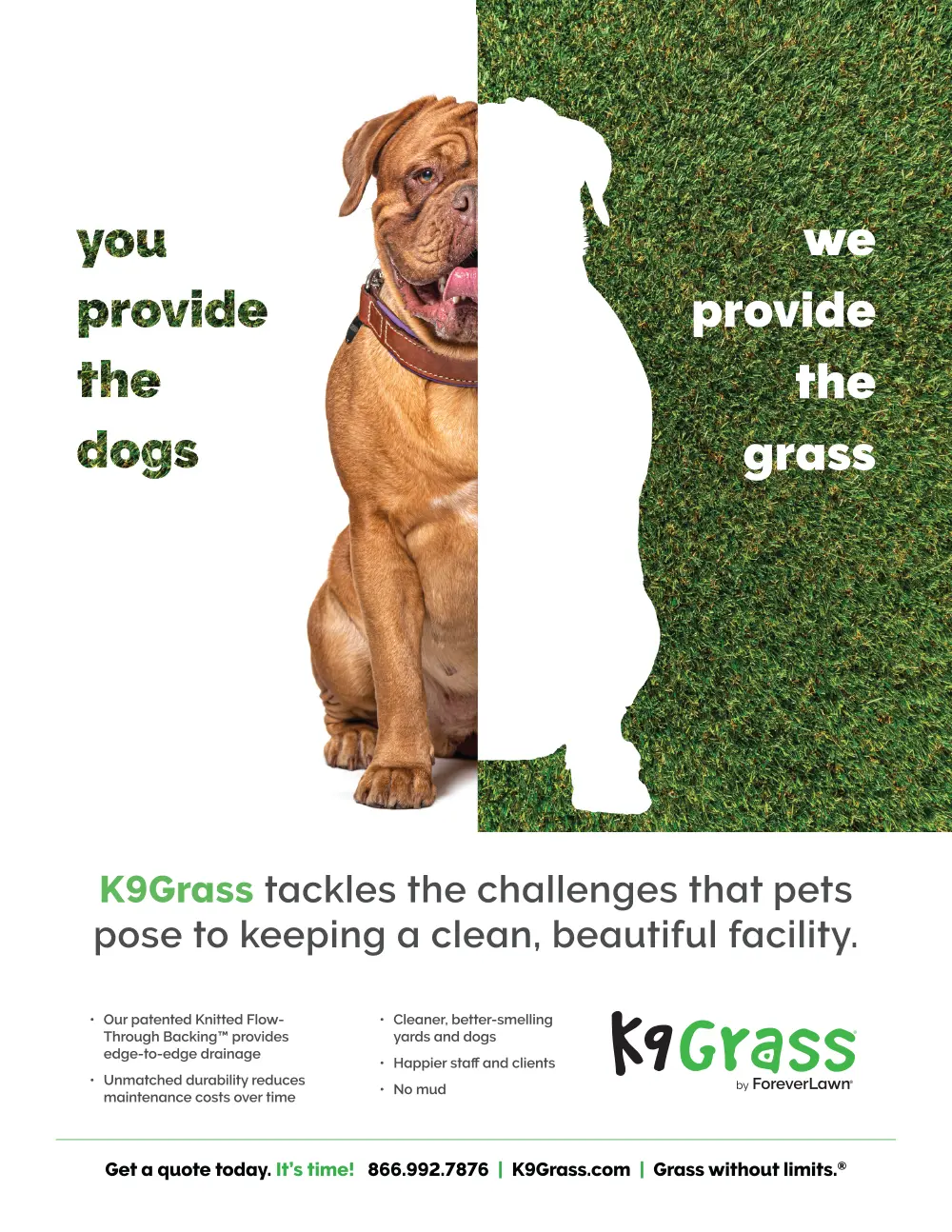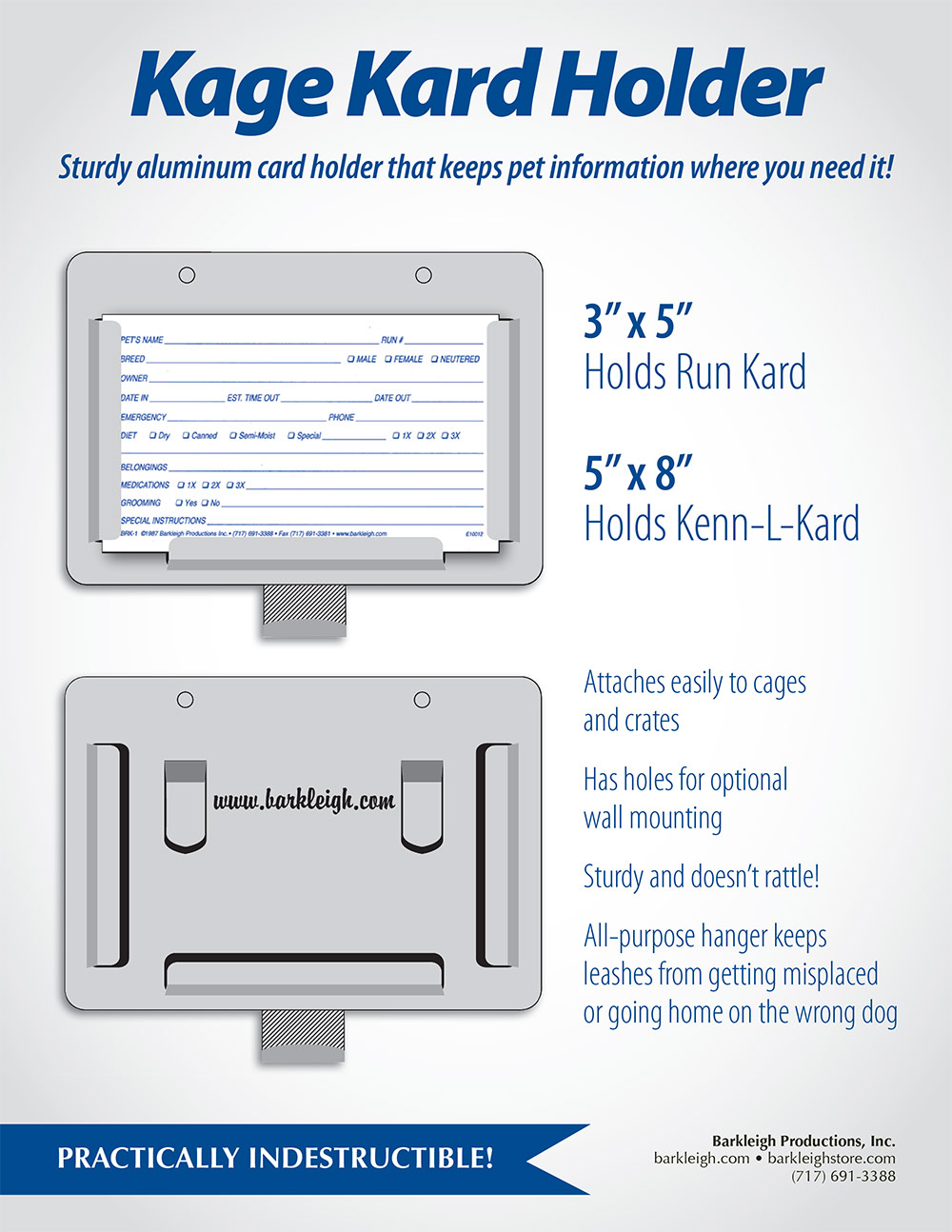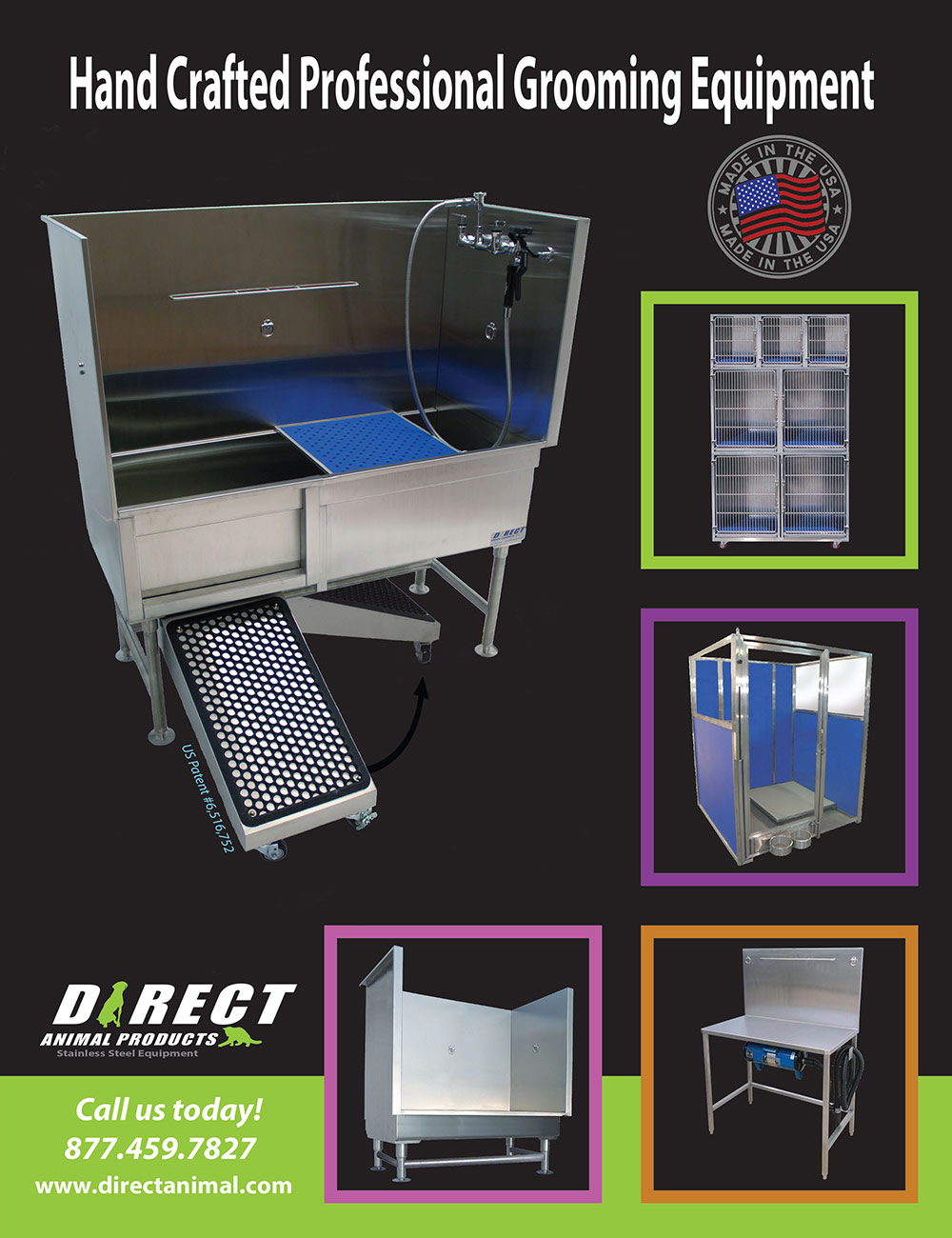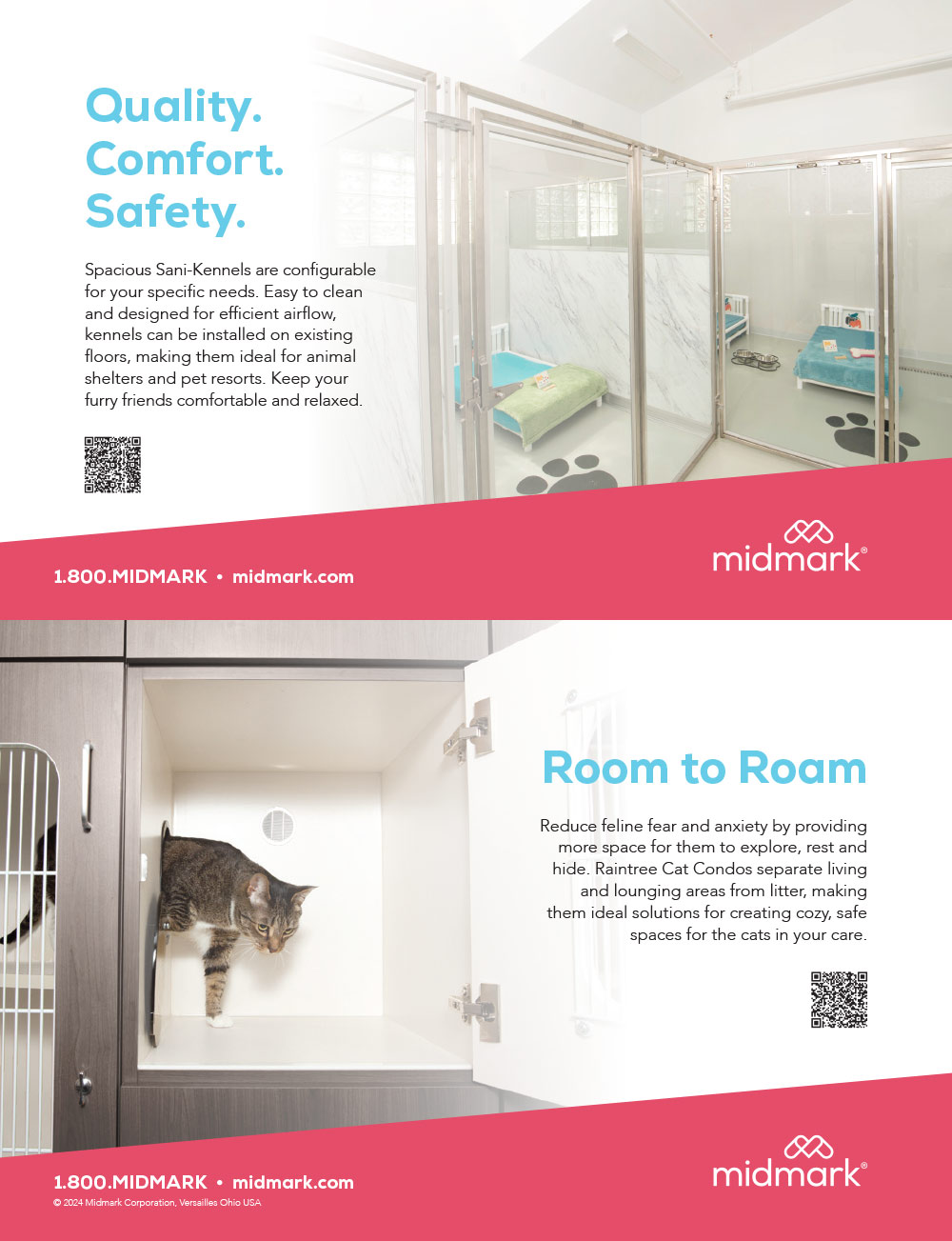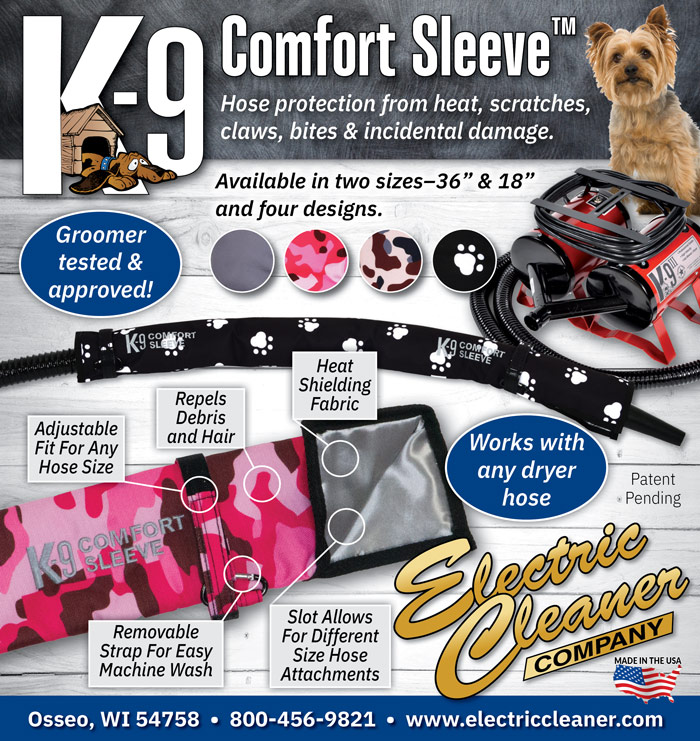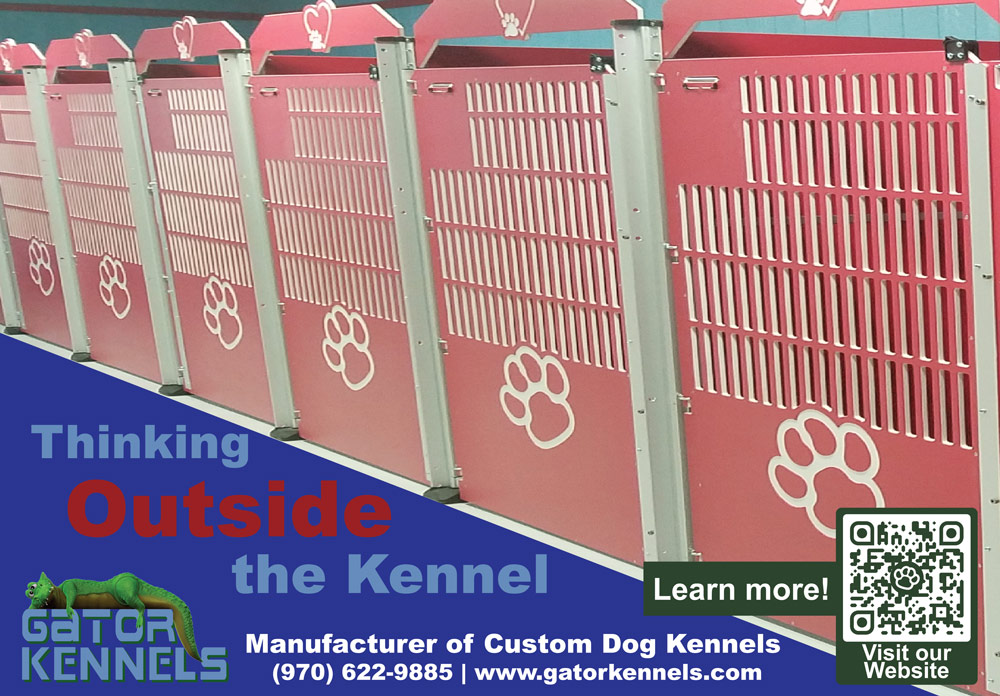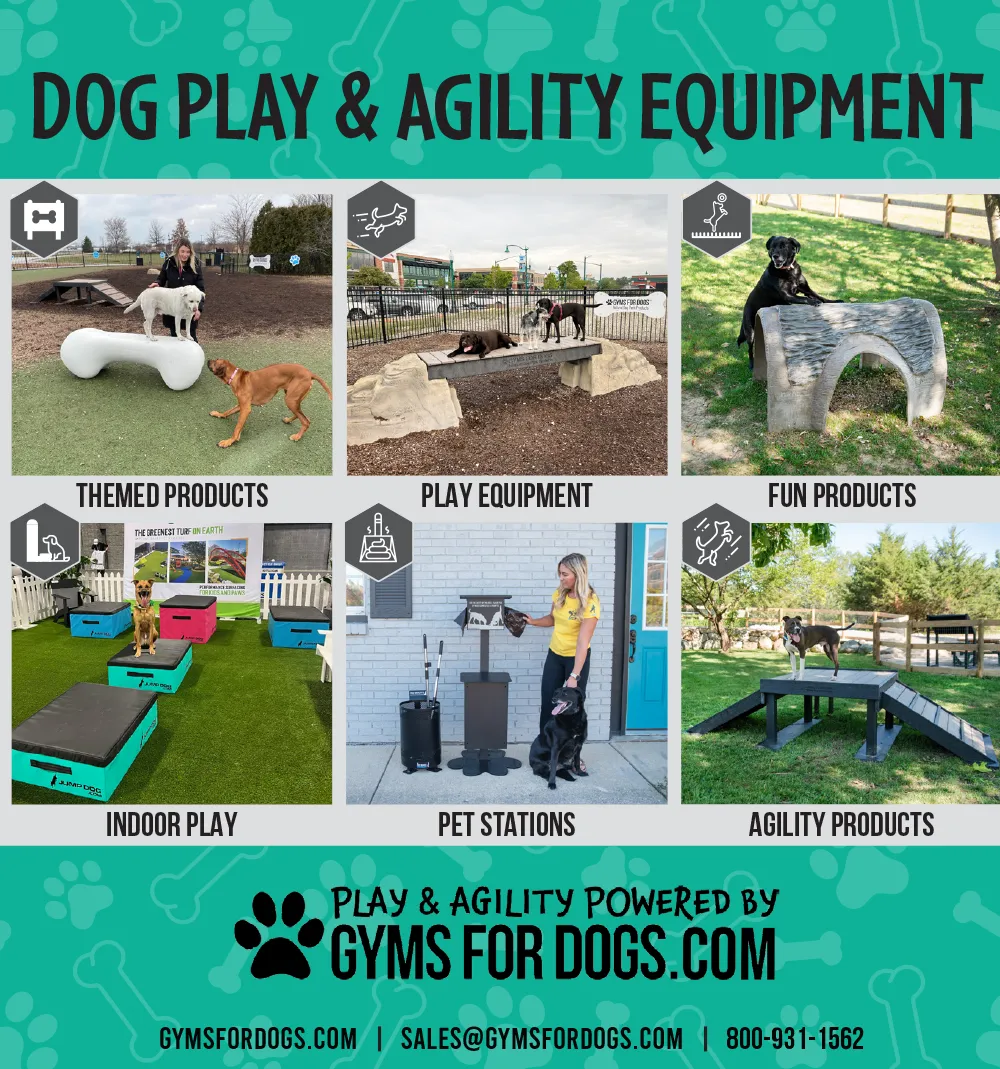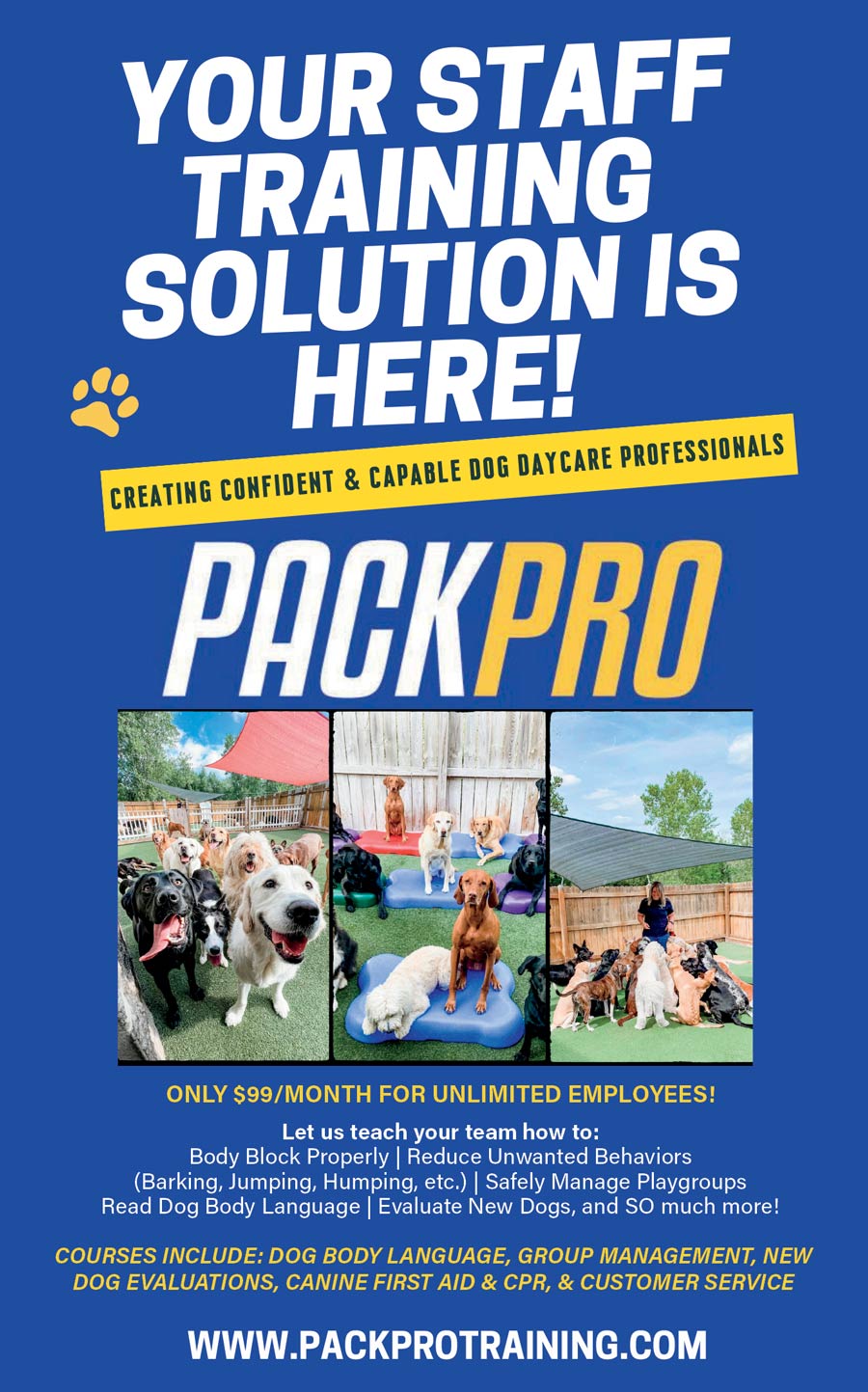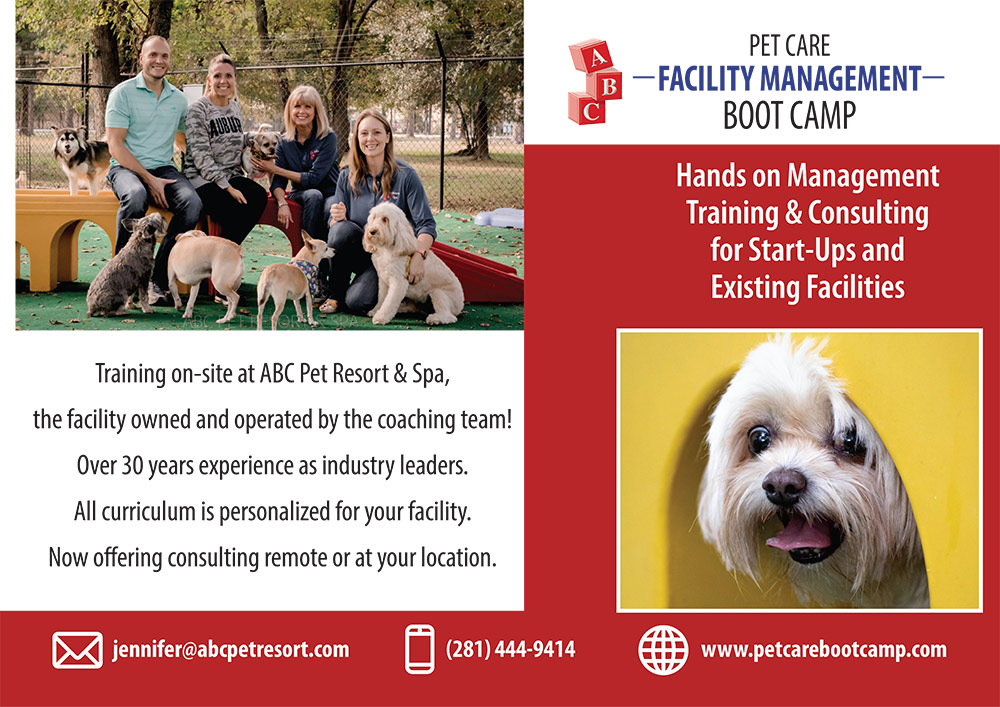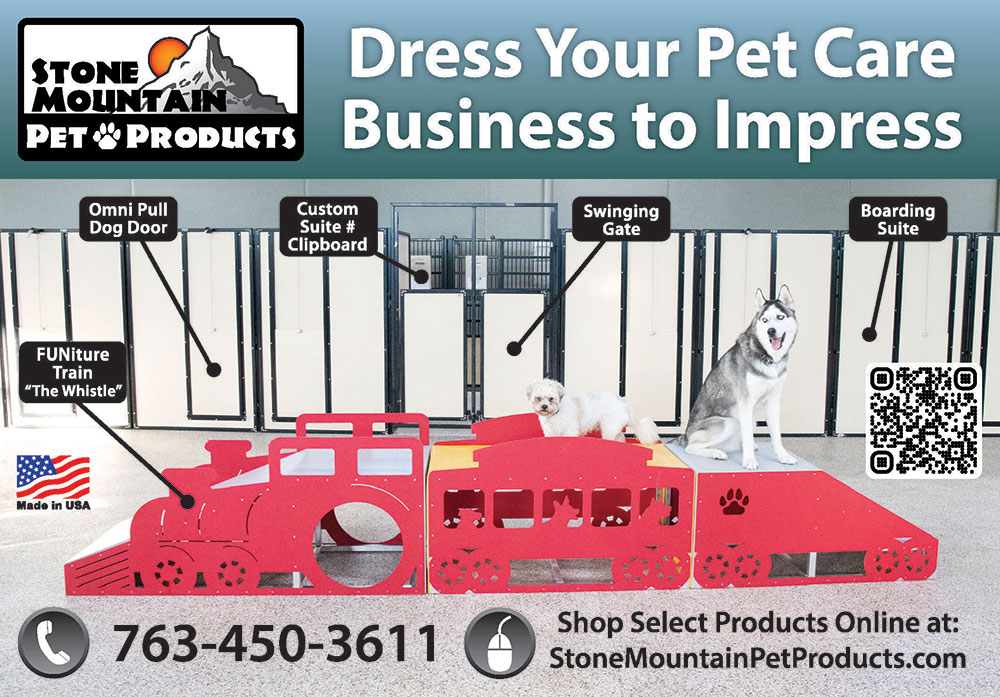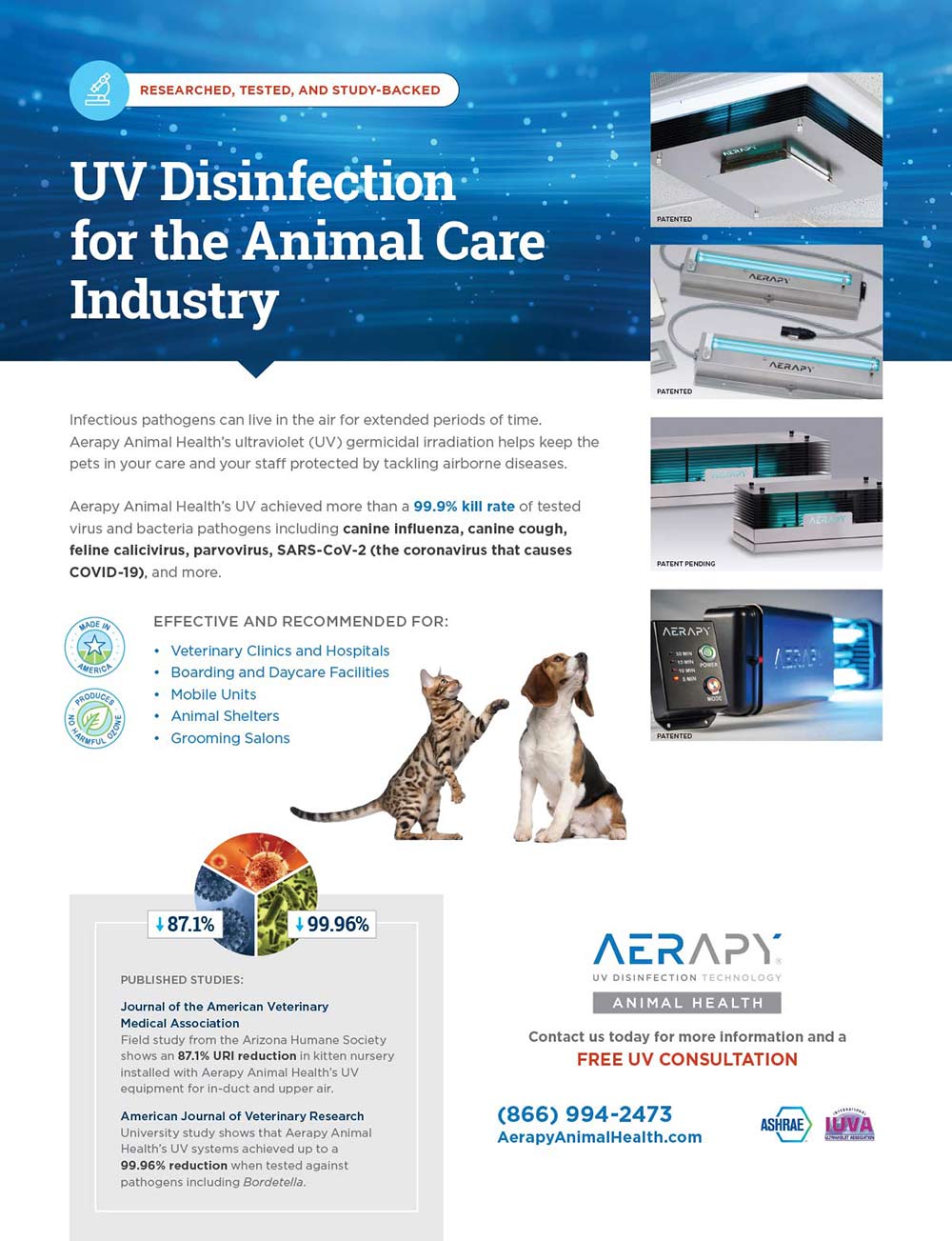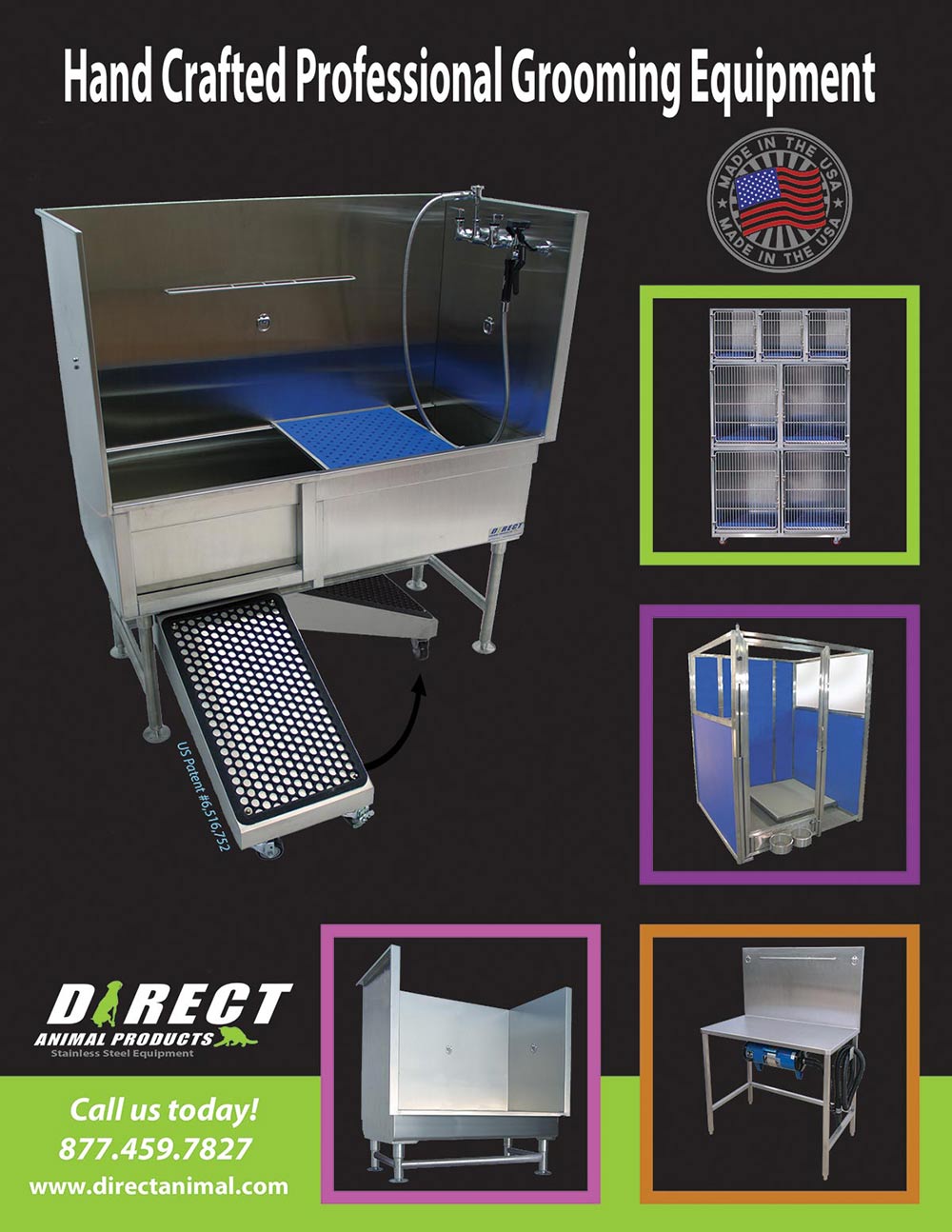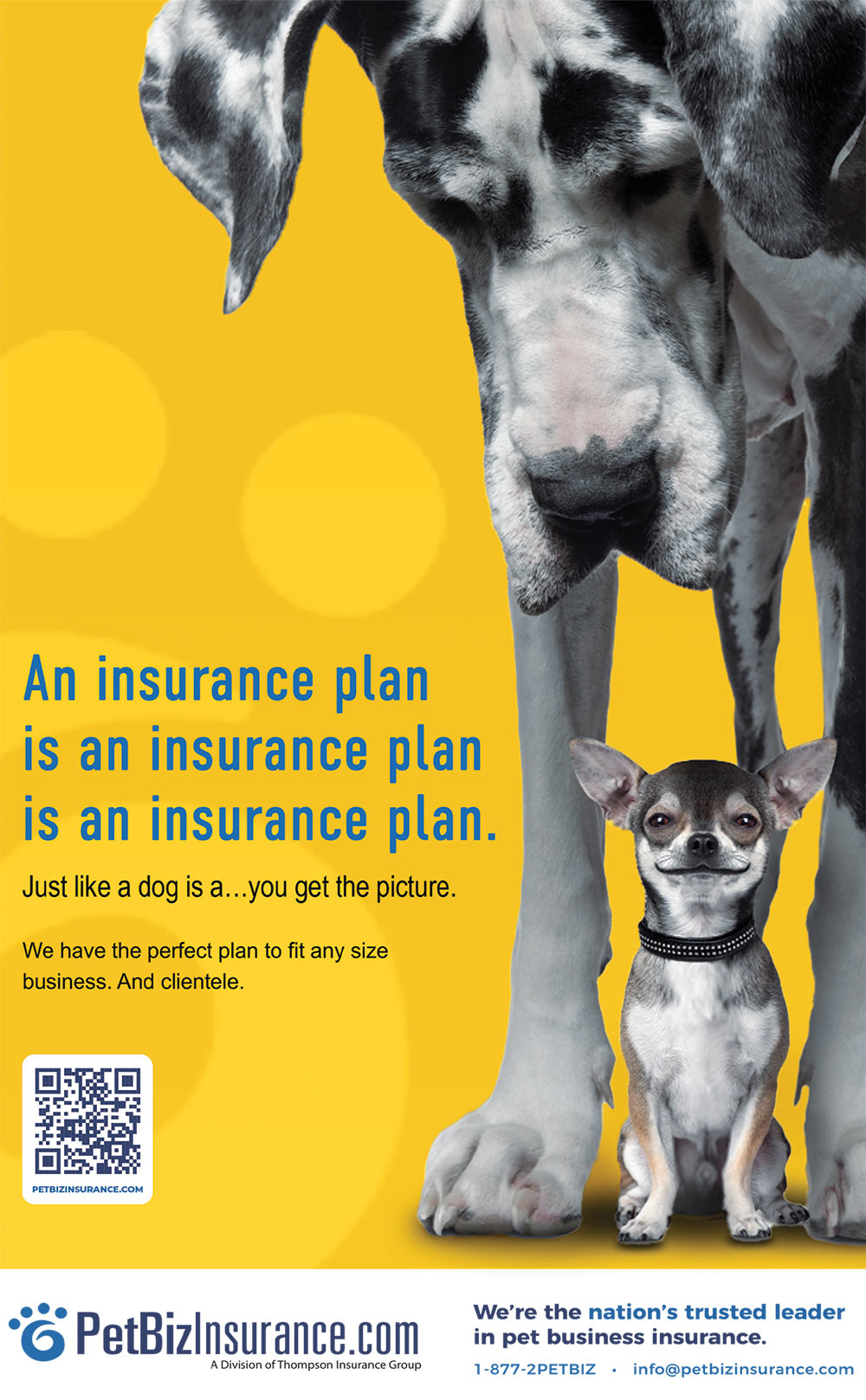Staff
Barkleigh Productions, Inc.
Rebecca Shipman
Laura Pennington
Brandi Aurelio
Carlee Kubistek
Luke Dumberth
Todd Shelly
Gwen Shelly
Adam Lohr
James Severs
Karin Grottola
Cassidy Ryman
Evan Gummo
CONTACT
General: (717) 691-3388
Editorial: rebecca@barkleigh.com
Advertising: james@barkleigh.com
Email: info@barkleigh.com

Animal Behavior
Business
Think Tank
Animal Health
Industry News
- Aerapy Animal Health7
- Alpha Tech Pet51
- Alpha Tech Pet56
- Barkleigh Store – Kage Kard Holder47
- Barkleigh Store – Kenn-L-Kards27
- Barkleigh Store – Boarding Kennels: The Design Process14
- Barkleigh Store – Boarding Kennels: The Design Process42
- Barkleigh Store – Groom Curriculum45
- Barkleigh Store – Holistic Pet Grooming30
- Barkleigh Store – The Pet Stylist Playbook55
- Best Friend Pet CareDigital
- Best Shot – Scentament Spa15
- CleanWise39
- Cosmos Bathing Systems38
- Direct Animal Products17
- Dog Kennel Flooring41
- Electric Cleaner Company54
- First Financial Bank29
- Gator Kennels8
- Gyms for Dogs52
- K9Grass2
- Kuranda Pro3
- Midmark5
- Natura Turf Pro22
- Odorcide13
- Online Doggy40
- Outstanding Pet Care20
- Pack Pro Training35
- Paragon Pet Grooming School26
- Pet Boarding and Daycare Podcast31
- Pet Business Marketing19
- Pet Care Bootcamp16
- Pet Shield49
- PetVet Magazine53
- PetBizInsurance.com21
- PetLift9
- Presido Custom Kennels10
- Professional Pet Boarding Certification46
- Puppy Playground34
- Rescue Disinfectants25
- Snyder Manufacturing Company23
- Stone Mountain Pet Products43
- Turnkey Inc.48
- Wag’n Tails11
Animal Behavior


 ime and time again, pet parents come to us with concerns about obedience and behavioral issues, believing that something is wrong with their dog. In most cases, the root of the problem isn’t the commands their dog does or doesn’t know—it’s the relationship the parent has with their furry companion.
ime and time again, pet parents come to us with concerns about obedience and behavioral issues, believing that something is wrong with their dog. In most cases, the root of the problem isn’t the commands their dog does or doesn’t know—it’s the relationship the parent has with their furry companion.
Understanding the Owner-Dog Relationship
When a dog doesn’t view their human as a trusted leader, obedience becomes optional in their eyes. So, the question is, how can we, as professionals in the pet industry, help bridge this gap and foster stronger relationships between dogs and their owners?

Strengthening Obedience Through Engagement
A simple yet powerful exercise is the “name game.” Each time a dog responds to their name and comes when called, we reward them with love and affection. Once a dog is consistently coming when called, we introduce a follow-up command: sit. Now, the routine becomes: come, sit, receive affection.
Keep in mind that we do this as a “working up” project. This process isn’t meant to be rigid; it’s a fun, interactive way to reinforce commands while the dog is in an active, playful state.

One of the most effective ways to improve a dog-owner relationship is through hand-feeding. This creates positive reinforcement, strengthens trust and ensures the dog looks to their human as a source of good things.

ReinForcing Bonds and Obedience at Home
One of the most effective ways to improve a dog-owner relationship is through hand-feeding. Instead of serving meals from a bowl, encourage owners to feed their dog directly from their hand. This creates positive reinforcement, strengthens trust and ensures the dog looks to their human as a source of good things. If an owner feeds a raw diet, they can get creative, making “pupcicles” or using a portion of kibble for training exercises.
Even a half-and-half approach is better than nothing at all. For example, encourage pet parents to keep half of their dog’s kibble in a treat pouch (or their bathrobe pocket) and feed it by hand while they are getting ready in the morning. When they are watching TV at night, they can throw bits of kibble to their dog or ask them to sit and feed them by hand. Soon, your clients will see that their dog’s trust in them as someone who always leads them to a good thing is reinforced.
Clients should also be encouraged to keep integrating obedience into everyday routines. Simple acts like giving a command before providing food or asking for a sit before going out the door for a walk reinforce leadership and build confidence in both the dog and the owner. And that benefits you and your team, too!

Consider It a Productive Partnership
Remember, at the heart of every well-trained dog is a relationship built on trust, consistency and engagement. As pet boarding and daycare professionals, our role isn’t just to teach commands; it’s to guide pet parents in creating meaningful, lasting connections with their four-legged companions. And when that bond is strong, obedience naturally follows!
Eve Molzhon is the creator and owner of Dog Handler Academy. Dog Handler Academy is a 100% online, automated employee training program designed specifically for dog daycares and boarding facilities. Our real-life daycare videos and online quizzes fast-track your new hires into understanding dog handling and care, saving you time and money. Courses cover basic and advanced dog handler skills, social cues and safety, client relations, and more. The mission of Dog Handler Academy is to provide employers training new hires with comprehensive material in a cost-efficient, consistent, and effective program. Our end goal is to create better handlers within our industry to ensure the proper care of animals.
Business

How to Stay Involved After Selling Your Pet Resort Business
 elling your pet resort business marks a pivotal moment, blending nostalgia with excitement for the future. It’s the culmination of an era defined by relentless dedication, unwavering passion for pets and years of hard-earned expertise.
elling your pet resort business marks a pivotal moment, blending nostalgia with excitement for the future. It’s the culmination of an era defined by relentless dedication, unwavering passion for pets and years of hard-earned expertise.
Yet, as one chapter closes, another beckons—a chapter brimming with fresh possibilities for personal and professional growth within this vibrant industry. Rather than bidding adieu to your legacy and community impact, consider leveraging your wealth of experience to embark on new ventures that uphold your enduring commitment to pets and their devoted guardians.
Your journey through the pet resort industry has endowed you with invaluable insights and skills. Seize the opportunity to guide the next generation of leaders by offering mentorship to incoming management teams. Additionally, serving as a consultant to the new owner ensures a seamless transition while allowing you to tailor your involvement to suit your preferences and availability. By imparting your expertise on effective management, superior customer service and emerging industry trends, you not only safeguard your legacy, but also foster a culture of excellence that endures beyond your tenure.
Stay firmly rooted in the local pet community by actively participating in events, supporting shelters and spearheading initiatives that resonate with your passion. Networking with like-minded individuals and organizations not only sustains your connection with the industry, but also opens doors to collaboration and inspiration for future endeavors. Remember, your presence at trade shows and gatherings serves as a testament to your ongoing commitment to the welfare of pets and their caregivers.

In conclusion, selling your pet resort business signifies not an end, but rather a transition—a transition ripe with opportunities to redefine your impact and legacy within the pet care industry. Whether through mentorship, community engagement, education, investment or volunteerism, your enduring commitment to pets and their human companions ensures that your passion continues to shape and enrich lives for years to come. Embrace the journey ahead with optimism and purpose, knowing that your influence extends far beyond the confines of a single business venture.
Eyal is the co-founder and Chief Development Officer of Pet Resort Hospitality Group. He has experience running all aspects of a pet resort including dog handling, reception, reservations, marketing, scheduling and managing employees. He works directly with pet resort owners to help them through the transition of partnering with PRHG and also provides hands-on strategic, operational and managerial support to create long-term value. Eyal is actively looking to build meaningful relationships with pet resort owners.
Business


 utbound calls help convert leads, deepen customer relationships and maximize revenue; however, there’s one major hurdle most owners run up against: getting staff to actually make the calls!
utbound calls help convert leads, deepen customer relationships and maximize revenue; however, there’s one major hurdle most owners run up against: getting staff to actually make the calls!
For some employees, outbound calls may feel like an unnecessary duty, a chore or even a task that causes emotional discomfort. If team members aren’t confident or excited about these valuable calls, they’ll hesitate, underperform or avoid them altogether.
That’s why it’s important to create a workplace culture that prepares for, supports and incentivizes outbound calls. When done correctly, this approach can transform outbound calls from a dreaded obligation into an engaging and rewarding part of the job.
The following are a few ways to turn your team into confident, enthusiastic callers.

An effective, standardized and straight-forward script is key to your outbound calling efforts, and it serves many functions, including the following:
- Delivers Compelling Messaging: A script ensures employees provide the most important information in a clear, persuasive way. Instead of struggling to find the right words or accidentally missing an important point, they can focus their energy on making all the appropriate calls with successful outcomes.
- Ensures Consistency and Accuracy: Scripts provide a structure and flow to the conversation and ensure all phone employees are on the same page—literally. With the information right in front of them, they can make sure every customer (and customer prospect) receives the most important, up-to-date information.
- Builds Personal Connections: Outbound calls are more than just sales; they’re part of an elevated customer experience. Keep in mind when developing your scripts that proactive communications demonstrate care and maintain a positive, active relationship with the pet parent. Include welcoming language and positive affirmations, training your team to use the customer’s name (and the pet’s) throughout the call.
- Prepares Your Team for Objections: Customers may push back for various reasons, but many objections are predictable. Having effective, scripted responses in their back pocket (or better yet, in a binder in front of them) can greatly increase an employee’s confidence and overall success.
- Empowers Your Team: Having a proven script takes away the guesswork and arms your team with the tools they need to produce results. This helps employees feel in control, less nervous, and better equipped to conduct meaningful calls that lead to bookings and upselling.
A proven phone script brings your calling team to the next level and gives every call a better chance of success. Not only that, but it also sets the groundwork for clear, objective tracking and performance evaluation, which means recording and listening to calls.

One of the most effective ways to keep employees engaged and motivated is by reviewing recorded calls. Rather than dreading criticism, employees should see call reviews as a tool for growth and positive recognition.
Many people don’t realize how they sound over the phone. Playing a recording back helps employees hear their strengths, recognize what’s working, understand what’s not and feel accomplished in their progress.
Try finding a successful call or part of a call from the employee and highlight it as a model for their success. If an employee hears themselves doing well, they’ll be better prepared, more motivated and most likely to follow best practices to replicate their good performance.
Listen to calls regularly for each phone employee and pick out examples of both effective and ineffective calls and review them in routine, one-on-one meetings. Be sure to acknowledge and praise successes while identifying areas that need improvement. Specific feedback is most useful, and it’s best to give actionable direction or point out things the employee did successfully rather than a blanket “good job” or “you could do better.”
When employees see call reviews as a chance to improve and gain recognition, they’ll feel more driven to give every call their best effort. Over time, this leads to improved results and a more engaged team.


Here are a few ideas to try:
- Competitions: Friendly competition adds energy to the outbound call process. Consider running a contest for a week or so for the most successful booking rate. This gives employees a goal to chase while making the task more exciting.
- Bonuses: Bonuses can also drive productivity in similar ways. For instance, consider offering a small monetary reward per successful outbound call ahead of a peak period like summertime.
- Public Praise: Public recognition furthers this effort. Acknowledge wins in team meetings, email shout-outs or a posted leaderboard to celebrate successes and kindle healthy competition.

4. Set Expectations
Up Front One of the best ways to get employees on board with outbound calls is to make them part of the job from day one. By including outbound calls during your hiring process, employees will be less likely to resist or avoid the task.
Here’s how to get employees on board from the get-go:
- Job Descriptions: Include outbound calls among the responsibilities listed in the job description. This helps set clear expectations as early as the application process. If necessary, you can also refer to the job description if an employee needs to get back on track.
- Interviews: Be straightforward with candidates and inform them outbound calls are part of the role. Ensure they understand the ways outbound calls benefit customer relationships. Ask them if they’ve ever made outbound calls before and gauge their comfort level. This can help you choose the candidates who will be most successful.
- Onboarding: Once the new employee is hired, get them trained on your scripts and call process early. This helps them feel prepared and confident to make their first calls and ensures they regard it as an important aspect of their job.
When your team understands the power outbound calls have to boost your revenue and enhance your customer service, they can feel more confident and motivated to improve. At the end of the day, both your business and your customers will benefit. You’ll see stronger pet parent relationships, more bookings and boosted revenue while building the most proactive team.
Ultimately, the key is to make outbound calls a priority, not an afterthought. With the right approach, your team will do more than just tolerate calls—they’ll embrace them as a valuable, rewarding part of their job.
Laura Laaman is president of Outstanding Pet Care. If you’re interested in growing your revenues with our proven and guaranteed services, schedule a consultation by calling 1-888-836-8740 or visiting www.outstandingpetcare.com/contact
Business

The Magic of Email Marketing
 ost pet business owners are stuck on the social media hamster wheel—posting, tweaking and praying for engagement. They drop captions, fiddle with hashtags and chase fleeting likes that don’t pay the bills. Then, at the end of each day, their content disappears into the social media graveyard, forcing them to start the whole process over again.
ost pet business owners are stuck on the social media hamster wheel—posting, tweaking and praying for engagement. They drop captions, fiddle with hashtags and chase fleeting likes that don’t pay the bills. Then, at the end of each day, their content disappears into the social media graveyard, forcing them to start the whole process over again.
Meanwhile, the smart ones—the ones actually laughing their way to the bank—skip the social media slog, and instead write a simple, story-based email, hit send and watch the bookings roll in. If you own a pet care business and you’re not emailing regularly (at least twice a week), then let me be blunt: You’re missing out on a TON of money.
1. “My clients don’t read emails.”
Really? Because every single pet owner I know checks their inbox every single day. Does everyone open every email? No. Do they open, read and engage with good emails? Yes! Your job is to be the email they actually WANT to open.
If you write boring, corporate, templated, newsletter-style emails, then yes, they’ll ignore you. But if you tell stories, entertain, give them a peek behind the scenes at the awesomeness that happens daily in your daycare and actually sell them on why your services make their life easier, they’ll read, and they’ll buy.
2. “I don’t know what to say in emails.”
This is just laziness disguised as confusion. If you can talk to a client in person for 30 minutes about their dog’s separation anxiety, grooming schedule or exercise routine, guess what? You have infinite content for emails!
Simple email subjects that engage include:
- Dog success stories and client case studies (why your services are good for dogs and owners).
- Why most dog daycares get it completely wrong (and why your unique daycare system leads to how you don’t).
- The number-one mistake dog owners make with their training (and how you can help).
- What activities have been happening this week (and what exciting things you have coming up next week).
- Your origin story, mission and company values (i.e., what makes YOU different).

3. “People will unsubscribe!”
Good! Unsubscribes clean your list. They weed out the tire-kickers, the freebie-seekers and the people who were never going to buy anyway.
The people who stay? Over time they’ll fall in love with your message. Your emails will move prospects through the “Know, Like, Trust” process and make it easy to find dog owners who want to give you money.
The truth is, if you’re so worried about unsubscribes that you never send any emails, then you might as well not bother having an email list! Email helps you attract the right clients and repel the ones who aren’t a good fit for your services.
Everyone thinks this will never happen to them, until it does…TikTok gets banned? You’re in trouble. Facebook changes its algorithm? Uh-Oh, bigger trouble. Instagram decides it will favor paid ads and limits reach to 0.1% of your followers? You guessed it. Even more trouble!
Your email list is one of the only assets where you fully control the platform. When someone joins your email list, they’re giving you permission to show up in their inbox, and that’s powerful.
Email Vs Social Media
Meanwhile, in the privacy of someone’s inbox, it’s just you and them. And because emails take a little longer to write, and most people are scared of writing, it means you can dominate a platform that your competition won’t be using. And that is how you turn leads into loyal, high-paying customers.
1. Start with a story: Something that happened to you, a client, a dog or even a bizarre event in your business.
Example: “Yesterday, we welcomed a new dog to the daycare. He’s a Cockerpoo called Benji. He’s a real livewire, full of energy, and his mom and dad we’re struggling to give him the exercise he needs.”
2. Relate it to a pain point: How does this connect to a real problem pet owners have?
Example: “See, like a lot of owners, Benji’s pet parents didn’t realize that underneath all the fluff, there beats the heart of a real working dog who can become difficult to handle, or even destructive, if their breed traits and exercise needs aren’t taken care of.”
3. Transition into a CTA (Call to Action): i.e., Sell something. Every. Single. Time.
Example: “That’s why Benji’s mom enrolled him in our new enrichment program, where Benji can practice his superpower of sniffing and finding things, which means he is fulfilled, happy and settled at home.
Do you feel guilty about leaving your dog home alone? Do you need help providing the exercise and stimulation your dog needs? Click here to enroll in our exclusive personalised enrichment program”
Boom. Email done.
The bottom line is, stop leaving money on the table. You don’t need fancy graphics. You don’t need perfect grammar. You don’t need to be a “writer.” You don’t even need ChatGPT. You just need to start telling stories using this forgotten communication tool that’s as reliable as a boomerang; send it out, and watch the money come right back to you.
Dom Hodgson is Europe’s leading pet business coach, and is known as the Pet Biz Wiz. His mission is to help pet service providers create superior customer service systems that enable them to build an impactful and profitable pet business. Dom has written over nine books, and is a much in-demand speaker. You can instantly download a free copy of his latest book “How to Disnify Your Doggy Daycare Business” by going to www.petbusinessmarketing.com/daycaremagic



Photos provided by Lexie Goldsmith
 n the early days of pet professional online forums, there were all types of shockingly horrible and inappropriate handling methods for cats, such as using vet wrap on paws, cage/bag bathing, scruffing and more. Thankfully, these days, groomers and other pet professionals are looking for more holistic and low-stress approaches for handling felines, and these modern and far kinder techniques are the future for pet care—which is a great thing for cats!
n the early days of pet professional online forums, there were all types of shockingly horrible and inappropriate handling methods for cats, such as using vet wrap on paws, cage/bag bathing, scruffing and more. Thankfully, these days, groomers and other pet professionals are looking for more holistic and low-stress approaches for handling felines, and these modern and far kinder techniques are the future for pet care—which is a great thing for cats!Scruffing involves using a hand behind the cat’s neck to hold a large amount of skin, aiming to imitate the way a kitten’s mother transports its kittens, causing a cat to relax their limbs. Scruffing is also used by tom cats when mating with queens and during fighting.
This is no longer a positive hold after a few weeks of age, as the reflex that causes relaxation disappears. It should not be mimicked by humans unless there are extreme circumstances, such as where a cat needs to be removed from a high-risk situation to avoid injury to itself or the handler.
Some of the reasons scruffing is not recommended include:
- Causes discomfort or pain for the cat, and therefore elevates aggression or increases sensitivity.
- Increases the likelihood of the handler being injured while attempting to scruff.
- Exaggerates feelings of fear, stress, frustration or loss of control, which can be interpreted by a cat as a negative association to the environment.
- Increased stress means increased cortisol, heart rate and body temperature, which can have adverse medical effects.
- Causes the cat to become aggressive from a fearful state.
- Hurts the relationship between cat and handler, where trust is essential.
Stress has effects on the feline body that you cannot see with the eye. Stress sends proteins to the kidneys, increases blood sugar levels and can cause long-term effects on a cat in renal failure. Stress can cause urinary tract blockages, and even cause severe tachycardia or respiratory distress resulting in death.
There are many far more suitable alternatives for handling cats, such as using light pressure or a towel, which can reduce their stress.
Using light pressure on certain areas can reassure the cat of where you would like them to be, instead of using a more aggressive approach such as scruffing.
1. Chin Hold: Use your thumb between the bones of the jaw and place the other four fingers around or on top of the head. You may also reverse this, using the thumb at the top of the head and fingers between the jaw bones. This prevents the cat from biting and sudden head movements.
2. Wrist Hold: This uses a gentle-pressure hold and gives you control of the head by simply using your wrist over the cat’s head when holding the paw, such as when clipping the nails.
3. Snake Hold: Use your fingers in a “V” shape to apply pressure and have control over the cat’s head when clipping, combing or wrapping the cat.
4. Football/Underarm Hold: Hold the cat under your underarm/body and roll the cat to access the groin and belly area.






Towel Methods
1. Leg Wrap: Wrap the back legs to access the front legs or wrap the front legs to access the back legs.
2. Head Wrap: A towel can also be used as an alternative to scruffing or using an elizabethan collar. Roll the towel up longways, wrap the towel around the neck and loosely tie it or secure it with a clip, avoiding the skin.
As you can see, there are many alternative and low-stress ways to handle a cat that don’t involve scruffing. Thankfully, with up-to-date training and research into feline health and behavior, we know better than to scruff.
There are many more opportunities to gain experience in reducing stress for cats in the boarding and grooming environment, and we should never stop learning and discovering ways to improve on our techniques to make things better for them.


Does it Make Sense for Your Business?
By Kate Titus
Photos provided by A Loyal Companion
 s a canine mobility specialist, I hear one question more than any other: “Do you know anyone who can care for my dog when I go out of town?” Sadly, the answer is often no.
s a canine mobility specialist, I hear one question more than any other: “Do you know anyone who can care for my dog when I go out of town?” Sadly, the answer is often no.
More pet owners than ever are looking for specialized services and products to support their companions who face mobility challenges due to age, illness or injury. According to Global Market Insights, the U.S. Pet Mobility Aids Market generated approximately $679 million in sales in 2023 and is projected to surpass $1 billion by 2030. This segment is not just a niche but a substantial, underserved market that craves compassion and expertise.
Not sure if this market is right for you? The following is a five-step opportunity assessment, which can help you determine if entering the mobility-challenged pet segment could benefit your business.

Step 1: Define the Problem—and the Solution.
Next, assess whether a feasible solution aligns with your existing business model. It’s essential to focus on the actual need itself rather than just the product or service you plan to provide. Take a close look at all aspects of that need, including any barriers to adopting your proposed solutions. Outline what is required to offer a compelling solution and consider what will spur change in consumer behavior.

Step 2: Identify Potential Customers and Their Problems.

Finally, evaluate their behavioral patterns, including service usage rates, brand loyalty and typical purchase occasions. Understanding when and why they seek out services will help you tailor your offerings to meet their specific needs.
When developing your customer avatar, it’s essential to dig deep and avoid vague assumptions. Leverage your internal data—such as surveys, interviews and back-end information—to effectively inform this avatar. Involving your team in the process can further enrich your insights, as diverse perspectives help create a more comprehensive understanding of your customer base.
With your customer avatar established, consider whether this is a service that your potential customers would be interested in purchasing. For example, review social media platforms and moderated forums to connect with pet owners in this market directly. They can offer candid insights into their concerns and desires.

Step 3: Recognize the Competition.
Begin by considering the full universe of alternatives your potential customers might turn to when seeking solutions for their mobility-challenged pets. Family and friends often serve as the first line of support, whether asking someone to pet-sit or seeking advice on caring for a mobility-challenged animal. Additionally, individuals in your community may offer similar services at lower prices, appealing to budget-conscious pet owners. More commonly, pet owners may even opt out of activities like travel that would necessitate the need for services.

Step 4: Evaluate the Operational Impact.
Next, assess your team’s current talents and limitations. Consider whether the necessary skills, expertise and experience can be trained or acquired through hiring. Identify who will be trained and how many team members will participate if training is needed. Caring for mobility-challenged animals requires a specific mindset, so it’s crucial to evaluate whether your staff possess the qualities necessary for this work, including patience, persistence, courage and empathy.
Furthermore, evaluate the functionality of your space for accommodating mobility-challenged pets. Start with the flooring; while many surfaces are easy to clean, they may pose traction issues for these pets. Assess other structural elements, such as doorways, kennels and dog doors, and the presence of steps or multi-level areas that could create challenges. Consider the layout of your play areas—rolling hills might be enjoyable for some pets but difficult for others.

Caring for mobility-challenged animals requires a specific mindset, so it’s crucial to evaluate whether your staff possess the qualities necessary for this work, including patience, persistence, courage and empathy.


Step 5: Consider the Financial Aspects.
To really put things in perspective, create three risk-versus-reward scenarios. For each scenario, outline your assumptions and projected financial performance, considering the likelihood of each outcome. Identify the basis for your judgments to ensure your analysis is rooted in solid reasoning.
Entering the mobility-challenged pet market is not just a business decision; it’s a chance to make a meaningful impact on the lives of pets and their owners. Pet parents are actively seeking solutions for their companions, and by stepping into this niche, you can meet that demand while enhancing your bottom line.
This is truly a win-win scenario. You’ll be providing essential services that improve the quality of life for mobility-challenged pets and their people, all while driving growth and profitability for your business.
Kate Titus is a canine mobility specialist and the founder of A Loyal Companion. Her thoughtful and innovative approach is driven by an unyielding dedication to quality of life for mobility-challenged pets AND their people. Kate is an award-winning author of two books about caring for mobility-challenged pets, Sit. Stand. Go! and Emotion to Motion, an Amazon #1 Bestseller in its category and Pinnacle Book Achievement Award winner. She has been featured in national publications and is a sought-after national speaker in the pet services industry. Contact Kate at ktitus@aloyalcompanion.com to learn more about integrating care for mobility-challenged pets into your business.
Profile of Success





Photos by Anchored Studios and Carla Duharte Photography
 t all started when I got into recreational dog sports with my personal dogs,” says Mireille Hernandez, founder and owner of Furrtropolis, a thriving pet care facility in San Jose, California. “My dogs loved it and it was so fulfilling for me. I felt like part of a community with others who were participating in dog sports”
t all started when I got into recreational dog sports with my personal dogs,” says Mireille Hernandez, founder and owner of Furrtropolis, a thriving pet care facility in San Jose, California. “My dogs loved it and it was so fulfilling for me. I felt like part of a community with others who were participating in dog sports”
Mireille’s first business venture, Domestic Canine, provided boarding, daycare, board-and-train programs and private training lessons out of her home. Once her business took off, Mireille began to envision creating a facility that would offer all these services—and much, much more. That’s when her vision for Furrtropolis began to take shape.
Mireille wanted to expand and incorporate dog sports foundation programs into her daycare and boarding services, offering these activities daily while creating a space where the pet-loving community could connect.


Photos by Anchored Studios and Carla Duharte Photography
 t all started when I got into recreational dog sports with my personal dogs,” says Mireille Hernandez, founder and owner of Furrtropolis, a thriving pet care facility in San Jose, California. “My dogs loved it and it was so fulfilling for me. I felt like part of a community with others who were participating in dog sports”
t all started when I got into recreational dog sports with my personal dogs,” says Mireille Hernandez, founder and owner of Furrtropolis, a thriving pet care facility in San Jose, California. “My dogs loved it and it was so fulfilling for me. I felt like part of a community with others who were participating in dog sports”
Mireille’s first business venture, Domestic Canine, provided boarding, daycare, board-and-train programs and private training lessons out of her home. Once her business took off, Mireille began to envision creating a facility that would offer all these services—and much, much more. That’s when her vision for Furrtropolis began to take shape.
Mireille wanted to expand and incorporate dog sports foundation programs into her daycare and boarding services, offering these activities daily while creating a space where the pet-loving community could connect.




“The big message of Furrtropolis is that we are focused on pet wellness as a whole—from physical and mental stimulation, to a healthy grooming experience, to nutrition, to continuous preventative care, holistic approaches, and more,” she continues. “I wanted to embrace different areas that promote an overall happy pet.”

As you enter Furrtropolis, you’re greeted by their boutique-style retail pet store, which showcases products from small business vendors—many of which are handmade or homemade and not typically found in big-box stores.
“On the grooming side, we are heavily connecting the gap between grooming and training,” says Mireille. “We’ve seen many pets who were nervous, scared, or had a bad previous experience.
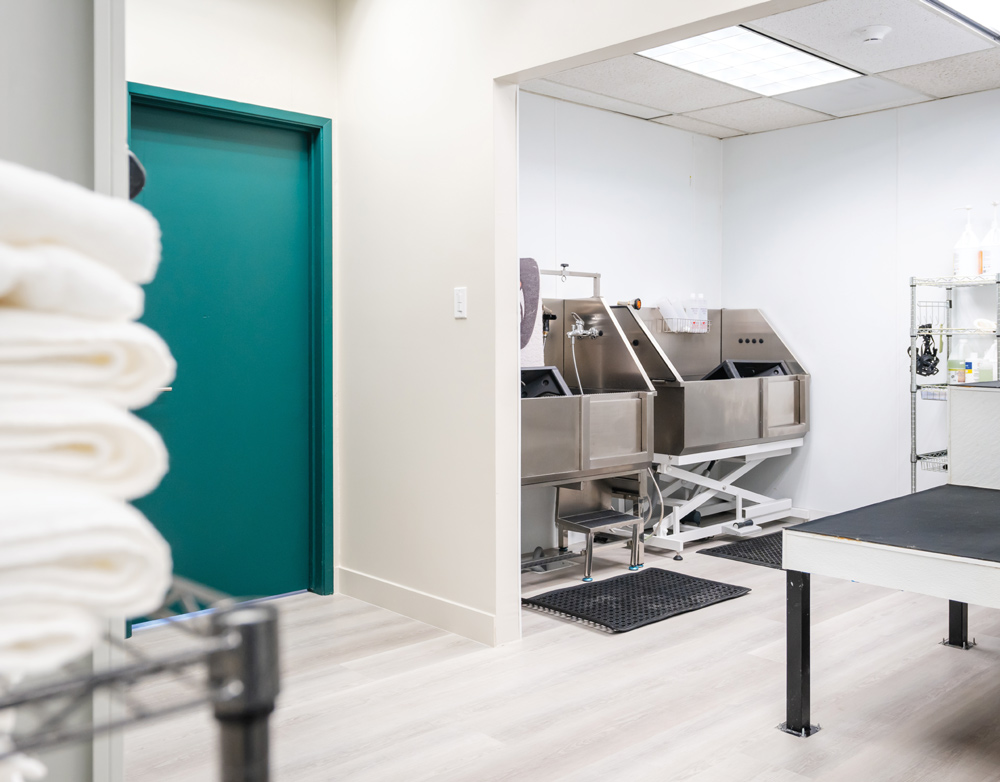

 On the grooming side, we are heavily connecting the gap between grooming and training. We’ve seen many pets who were nervous, scared, or had a bad previous experience.
On the grooming side, we are heavily connecting the gap between grooming and training. We’ve seen many pets who were nervous, scared, or had a bad previous experience. 
Furrtropolis prides itself in being a place where pet parents and sport and working dog handlers can connect. Training clubs and other groups can even rent space in the facility to hold classes and seminars. In addition, veterinarians have hosted pop-up events at the facility, providing services such as vaccines and fecal testing, and wellness therapists have offered pet reiki, acupuncture and massage therapy. Birthday parties and special events keep their space-rental calendar busy.
Every dog that signs up for daycare or boarding at Furrtropolis must go through an evaluation to assess how they adjust to a new environment. Mireille or another staff member speaks with the owner at length about the pet’s background and needs. Then, the dog stays for a half-day in daycare to observe how they interact in the environment and with staff members. All boarding dogs also participate in daycare during their stay.

“We work with different trainers who come onsite to work one on one with our daycare dogs,” Mireille says. “Our most popular training program is our Day Training program for both daycare and boarding dogs.”


Their website, www.furrtropolis.com, allows visitors to take an online tour of the facility, view available services and access the client center, where they can make reservations, update pet profiles and pay their bill. To boost their online presence, Mireille now has a dedicated social media person to help attract new clients.

To conclude, Mireille adds, “We envision a world where every pet enjoys a life of fulfillment and support through a thriving and connected community of passionate pet owners, sport/working handlers, and small business pet product providers.”
With the goal to be the premier destination that seamlessly integrates dog sports, training and exceptional pet care while fostering collaboration with other innovative small businesses, Furrtropolis is truly a pet oasis.



By Fernando Camacho
 e can all agree that pet parents want the absolute best for their furry friends. Whether they’re looking for daycare, boarding or enrichment services, they’re not just going to pick the first place they find. More than likely, they’re going to research, compare and—most importantly—look for signs that your business is trusted by other pet owners. This is where social proof comes in…
e can all agree that pet parents want the absolute best for their furry friends. Whether they’re looking for daycare, boarding or enrichment services, they’re not just going to pick the first place they find. More than likely, they’re going to research, compare and—most importantly—look for signs that your business is trusted by other pet owners. This is where social proof comes in…
Social proof is one of the most powerful ways to build credibility, establish trust and differentiate yourself from the competition. When potential customers see real evidence that others love and trust your business, it makes their decision process much easier. Let’s break down five different types of social proof and how you can leverage them to strengthen your brand.

Here’s how to use them effectively:
- Encourage happy customers to leave reviews. After a great experience, send a follow-up text or email with a direct link to leave a review.
- Highlight the best ones. Showcase glowing reviews on your website, social media and even in your facility.
- Respond to reviews. Thank positive reviewers and professionally address any negative feedback. This shows that you care about your customers’ experiences.

Here’s how to use them effectively:
- Partner with local pet influencers. A simple visit, Instagram post or review from them can introduce your business to a whole new audience.
- Build relationships with vets and trainers. If local professionals recommend your services, it instantly increases trust.
- Engage with community organizations. Sponsor local dog events or partner with rescues to show that you’re actively involved in the pet care community.

Here’s how to use them effectively:
- Write blog posts. Feature real stories of how your daycare or boarding services have positively impacted dogs and their owners.
- Create before-and-after content. Show progress over time—whether it’s behavior improvements, socialization skills or just an anxious dog becoming comfortable in your space.
- Use video testimonials. If a customer is willing, a short video of them talking about their experience can be extremely impactful.


Awards, certifications and professional memberships signal that you take your business seriously.

Here’s how to use them effectively:
- Display awards and certifications on your website. Whether it’s “Best Pet Boarding Business” in your city or an industry-specific certification, make sure people see it.
- Mention them in your marketing. Social media posts, newsletters and even signage in your facility can highlight these achievements.
- Keep striving for more. If you don’t have any yet, look into local and industry awards or professional certification programs to boost credibility.

Here’s how to use it effectively:
- Encourage comments and shares. Ask fun questions, post interactive polls and create content that sparks conversation.
- Feature customer shout-outs. Highlight pet parents who frequently engage with your posts.
- Respond to comments. Show that you’re active and care about your community by responding.

Social proof isn’t just about collecting good reviews and posting pictures on social media; it’s about creating a reputation that speaks for itself.
So, start showcasing the amazing experiences your pet care business is already providing, as well as the accomplishments and achievements, and you’ll change how the public sees your business and give your sales process a boost.
Fern is the founder of Overdog Digital, a digital marketing & consulting agency that helps dog daycare and boarding facilities attract, convert, and keep more customers by creating winning marketing campaigns and providing the business guidance to build momentum and spark long-term growth. Fern also has programs to train daycare staff, is a dog behavior consultant, and has a dog training business in New Jersey. He is the author of eight books and a popular speaker at national conferences and private events. To join The Dog Daycare Business Think Tank or ask a question, go to: www.facebook.com/groups/dogdaycarethinktank

 ecent advancements in canine chemotherapy have turned what used to be a terminal cancer diagnosis into viable treatment paths, offering a glimmer of hope for pet owners. However, adverse reactions to chemotherapy are common.
ecent advancements in canine chemotherapy have turned what used to be a terminal cancer diagnosis into viable treatment paths, offering a glimmer of hope for pet owners. However, adverse reactions to chemotherapy are common.
Eighty percent of dogs undergoing treatment experience at least one side effect and 32% suffer from serious reactions. Specific symptoms usually depend on the drug being used and how aggressive the treatment is, along with the age and health of the dog.
While most side effects are mild and require only monitoring or light treatment, some can be life-threatening and result in hospitalization, and possibly an end to the cancer regimen.
The following are the three main areas where adverse effects of chemo can occur and the signs to be aware of.

Treating hair loss brought on by chemo in dogs is fairly straightforward. Regardless of the severity of the thinning, the dog will likely need a haircut to even out its coat. If shedding or patching are bad enough to impact the aesthetic or cause discomfort for the dog, shaving may be the best option. Ultimately, the decision is up to the owner.

Monitoring is the most important step to take in keeping blood cells at a healthy amount. The veterinary oncologist often prescribes antibiotics as a boost to the immune system if white blood cell counts begin to dip. If red blood cell levels are looking low, the dog may require a blood transfusion to prevent more serious issues and potential hospitalization.

As with blood cell counts, the most important step in managing digestive issues caused by chemotherapy is monitoring. Open communication between vets, owners, and caretakers about patterns in appetite and stool is critical. If a dog is experiencing a decrease in appetite, new options in making the dog’s food more appealing can be pursued, such as heating food to body temperature in the microwave, or enhancing the dog’s diet with low-sodium broth or home-cooked alternatives. Appetite stimulants are also available via prescription from the pet’s veterinarian.
Since the animal is already weakened by cancer and chemotherapy treatment, anorexia can quickly turn dangerous and require hospitalization. In drastic situations, a dog may require a feeding tube or IV to avoid starvation.
Vomiting and CID are both common and important to stay on top of, as both symptoms can lead to potentially deadly dehydration and halt the chemo regimen. There are effective anti-emetic (anti-vomiting) medications that are fast-acting and crucial for certain chemotherapy protocols. Vomiting can happen quickly after the chemotherapy dosing starts, but sometimes dogs need to be on anti-emetics even at the time of chemo treatment to be sure it can occur without the dog having a reaction.
Unlike vomiting, which happens immediately, CID can occur hours or days following a chemo dose. Owners and caretakers will need to monitor the pet and make sure that if the dog is exhibiting CID, the animal is drinking extra water to compensate. There is also a newer medication that can be prescribed by the pet’s veterinarian which normalizes fluid influx in the GI tract. Both methods are great steps to diminish likelihood of a trip to the hospital for rehydration via IV.
Improving a dog’s health after a cancer diagnosis is a constant battle, and even the best possible treatment plan can cause adverse symptoms. However, by being aware of the side effects of chemotherapy and maintaining close communication with the dog’s owner and veterinarian, you can play a part in helping the dog successfully navigate their cancer treatment.
Andre Teixeira, DVM, Ph.D., received his DVM degree in 2009 and then his Ph.D. degree in Animal Science. He joined Jaguar Health’s team in June 2017, bringing nearly 10 years of experience in animal pharmaceutical development. He now serves as the Sr. Director of Animal Health and is responsible for the development of animal health clinical studies, protocols and publications.
New Products

Designed for cats and dogs, this innovative water dispenser features a high-density, three-layer filtration system to remove impurities, soften water, and maintain pets’ health. Available with a 2L capacity, it ensures ample hydration for single or multi-pet use. The fountain’s wireless pump operates at an ultra-quiet 9 dB, minimizing noise and vibration to create a calming environment for sound-sensitive pets. The completely separate tank and base design allows for effortless refills and prevents cable damage or electric shock during cleaning. Choose between continuous or intermittent flow modes, and enjoy colorful LED light options. Available in white or black. elecomusa.com

Wisdom & Grace
1 Peter 5:7
NIV BIBLE

Thanks for reading our May/June 2025 issue!



